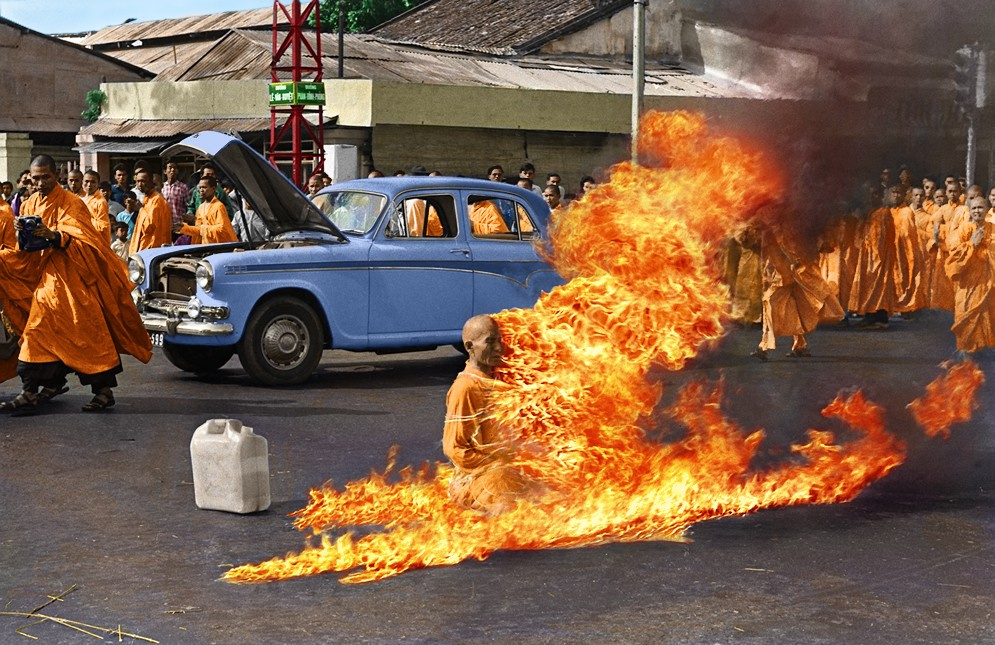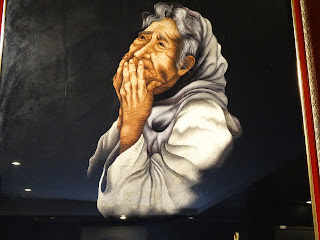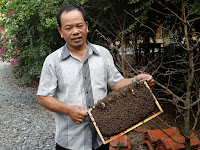Da Nang (Hue), Vietnam
At the most narrow spot in Vietnam (30 miles
wide) is the harbor city of Da Nang and not far away is Hue, the old Royal Capital
of the last King of this country. We paid a visit to Hue,
naturally taking a bus. I never really noticed how I don't like sitting on a bus. The seats are narrow, the legroom poor at best. People bump into me when I sit in the aisle seat to be able to stretch my legs somewhat.
 |
| Fishermen in Strange Round Boats |
naturally taking a bus. I never really noticed how I don't like sitting on a bus. The seats are narrow, the legroom poor at best. People bump into me when I sit in the aisle seat to be able to stretch my legs somewhat.
 |
| Moated Citadel |
There was close, door to door fighting at The Citadel for 25 straight days leaving the Palace mostly in rubble.
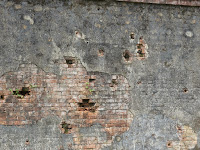 |
| Shell Holes in the Walls From the Fighting |
Efforts have been made to restore some buildings but those restorations look and feel like modern antiques. Read fake. I was disappointed. The original splendor can be felt but can not be seen. The layout of the Palace on a map
 |
| One of the Original Gates |
showed me how it used to be but very little is original. The complex is large, spreading over an area of some 5 square miles. But we were given only about 50 minutes by the tour operator to explore and it was way too little time.
 |
| Renovated Section |
 |
| Ceiling in the Renovated Section |
All I had time for was to walk the new antique section. So what can I report about The Citadel? That it is a ruin?
 |
| Decoration Over the Arch |
It sure is not what I anticipated. I was told it is a representation or even copy of the Chinese Emperor’s Palace, but I can not really say because there was not enough time to explore and there was too much destruction.
Naturally we had to visit a temple. This
one, the
Thien Mu Pagoda, was actually very different and interesting. Again, not enough time was allowed to see items in detail and to relax while wandering around the site.
A seven story, octagonal brick pagoda stood near the entrance and even though I asked people, I never found out its significance. The location of this monastery, right on the shore of the Perfume River, was picturesque. Vivid colored dragon-boats sat at the shore line waiting for tourists.
The buildings were set in a park-like setting, nicely landscaped and trees were expertly trimmed and formed into bonsai shapes. You guessed it, not enough time was allowed to explore in depth.
 |
| Thein Mu Pagoda |
Thien Mu Pagoda, was actually very different and interesting. Again, not enough time was allowed to see items in detail and to relax while wandering around the site.
 |
| Carving Inside the Pagoda |
A seven story, octagonal brick pagoda stood near the entrance and even though I asked people, I never found out its significance. The location of this monastery, right on the shore of the Perfume River, was picturesque. Vivid colored dragon-boats sat at the shore line waiting for tourists.
 |
| Dragon Boats |
The buildings were set in a park-like setting, nicely landscaped and trees were expertly trimmed and formed into bonsai shapes. You guessed it, not enough time was allowed to explore in depth.
This monastery had a car in storage we all know well from an old newspaper picture. It was in the news all over the world. Remember the Vietnamese Monk who set himself on fire in the 1960’s to protest the Government's policies? He was protesting the Government's discrimination against Buddhists and their violation of religious freedom.
 |
| The Monk's Blue Car |
In the background of the picture is the blue car he used to get to the place where he set himself alight. The monastery was displaying the actual car he used. It was an odd model car I have never seen before.
We stopped for lunch, stopped at a pearl seller shop, stopped at a silk embroidery factory, stopped at a “factory” selling incense sticks and straw cone hats.
We had time for all of that. We were given no time however for the reason we took this excursion, to explore the antique places. I felt a bit like being used to buy stuff in Vietnam to help the economy, rather than educating myself about Vietnam; like I intended to do when I started this trip.
We stopped for lunch, stopped at a pearl seller shop, stopped at a silk embroidery factory, stopped at a “factory” selling incense sticks and straw cone hats.
 |
| Silk Embroidery |
 |
| Working on Embroidery |
 |
| Making Cone Hats |
We had time for all of that. We were given no time however for the reason we took this excursion, to explore the antique places. I felt a bit like being used to buy stuff in Vietnam to help the economy, rather than educating myself about Vietnam; like I intended to do when I started this trip.
 |
| King TuDuc's Crypt |
Another 2 ½ hour bus ride back.
What was informative was the fact that this
was the 2nd day of the New Year’s Festival. The roads were packed
with travelers. It is customary for people to go home at this time of year and
honor their dead, honor their ancestors and to bring back gifts for their
living relatives and to eat, drink and be merry; and, to invite the spirits of
the
dead ancestors to participate in the festivities? All along the bus trips,
looking out the window, I saw hyper activity. Traffic was tremendous. Yellow
chrysanthemums were being sold to bring good luck and fortune for the coming year,
the year of the goat. In some shopping areas there was a field of yellow.
Bargaining was tried by many but the prices, because of the holiday, were higher
than usual. Two potted plants sold for about $10. - US. This is a lot of money
when your monthly income is just around $300. - US on average. These pots are
placed left and right of the house entrance to allow good luck to enter. The
yellow color represents the color of gold. So let gold or good fortune flow in
this house, is the message to the spirits.
Nobody
cooks for the 8 days of the New Year’s Festival; most people just eat sweet
snacks, drink lots of beer and go to a restaurant for dinner. It is an
expensive time of year, celebrating the arrival of a new Zodiac period. The travelers
and the family who welcomes the travelers pay dearly. The gifts, the food and drinks
add up to a large expense for all. Yet most celebrate and most would not miss this Festival. It is an ancient tradition and we were smack in the
middle of it all. This was the real life of Vietnam but unfortunately I only
saw it through the windows of a moving bus, there was no time to stop and see
real Vietnam life, we had to get back to the ship. The tide and our ship wait for nobody.
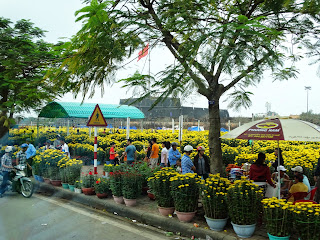 |
| Yellow Flowers Bring Good Luck at New Years |

